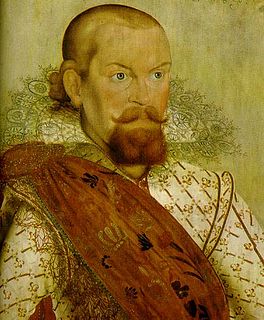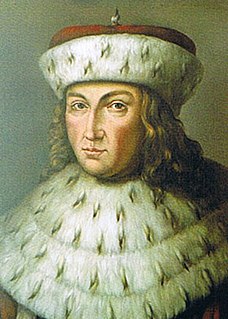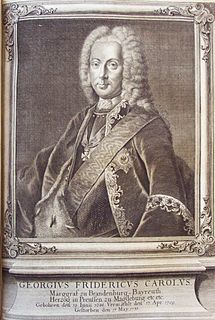 W
WThe Principality of Bayreuth or Margraviate of Brandenburg-Bayreuth was an immediate territory of the Holy Roman Empire, ruled by a Franconian branch of the Hohenzollern dynasty. Since Burgrave Frederick VI of Nuremberg was enfeoffed with the Margraviate of Brandenburg in 1415/17, the Hohenzollern princes transferred the margravial title to their Franconian possessions, though the principality never had been a march. Until 1604 they used Plassenburg Castle in Kulmbach as their residence, hence their territory was officially called the Principality of Kulmbach or Margraviate of Brandenburg-Kulmbach until the Empire's dissolution in 1806.
 W
WAlbert III was Elector of Brandenburg from 1471 until his death, the third from the House of Hohenzollern. A member of the Order of the Swan, he received the cognomen Achilles because of his knightly qualities and virtues. He also ruled in the Franconian principalities of Ansbach from 1440 and Kulmbach from 1464.
 W
WAlbert II was the Margrave of Brandenburg-Kulmbach (Brandenburg-Bayreuth) from 1527 to 1553. He was a member of the Franconian branch of the House of Hohenzollern. Because of his bellicose nature, Albert was given the cognomen Bellator during his lifetime. Posthumously, he became known as Alcibiades.
 W
WChristian Friedrich Carl Alexander was the last margrave of the two Franconian principalities, Bayreuth and Ansbach, which he sold to the King of Prussia, a fellow member of the House of Hohenzollern.
 W
WCasimir of Brandenburg-Bayreuth was Margrave of Bayreuth or Margrave of Brandenburg-Kulmbach from 1515 to 1527.
 W
WChristian, Margrave of Brandenburg-Bayreuth was a member of the House of Hohenzollern and Margrave of Brandenburg-Kulmbach.
 W
WChristian Ernst of Brandenburg-Bayreuth was a member of the House of Hohenzollern and Margrave of Brandenburg-Bayreuth.
 W
WFrederick was the last Burgrave of Nuremberg from 1397 to 1427, Margrave of Brandenburg-Ansbach from 1398, Margrave of Brandenburg-Kulmbach from 1420, and Elector of Brandenburg from 1415 until his death. He became the first member of the House of Hohenzollern to rule the Margraviate of Brandenburg.
 W
WFrederick I of Ansbach and Bayreuth was born at Ansbach as the eldest son of Albert III, Margrave of Brandenburg by his second wife Anna, daughter of Frederick II, Elector of Saxony. His elder half-brother was the Elector Johann Cicero of Brandenburg. Friedrich succeeded his father as Margrave of Ansbach in 1486 and his younger brother Siegmund as Margrave of Bayreuth in 1495.
 W
WFrederick Christian of Brandenburg-Bayreuth, was a member of the House of Hohenzollern and Margrave of Brandenburg-Bayreuth.
 W
WFrederick II of Brandenburg, nicknamed "the Iron" and sometimes "Irontooth" (Eisenzahn), was a Prince-elector of the Margraviate of Brandenburg from 1440 until his abdication in 1470, and was a member of the House of Hohenzollern.
 W
WFrederick, Margrave of Brandenburg-Bayreuth, was a member of the House of Hohenzollern and Margrave of Brandenburg-Bayreuth.
 W
WGeorge Frederick Charles, Margrave of Brandenburg-Bayreuth, was a German prince, member of the House of Hohenzollern, nominal Margrave of Brandenburg-Bayreuth-Kulmbach (1708–35) and Margrave of Brandenburg-Bayreuth (1726–35).
 W
WGeorge Frederick of Brandenburg-Ansbach was Margrave of Ansbach and Bayreuth, as well as Regent of Prussia. He was the son of George, Margrave of Brandenburg-Ansbach and a member of the House of Hohenzollern. He married firstly, in 1559, Elisabeth of Brandenburg-Küstrin. He married secondly, in 1579, Sophie of Brunswick-Lüneburg, daughter of William of Brunswick-Lüneburg and Dorothea of Denmark.
 W
WGeorge William of Brandenburg-Bayreuth was a member of the House of Hohenzollern and Margrave of Brandenburg-Bayreuth.
 W
WJohn, nicknamed the Alchemist was a Margrave of Brandenburg-Kulmbach and served as the peace-loving Margrave of Brandenburg after the abdication of his father, Frederick I, the first member of the House of Hohenzollern to rule Brandenburg.